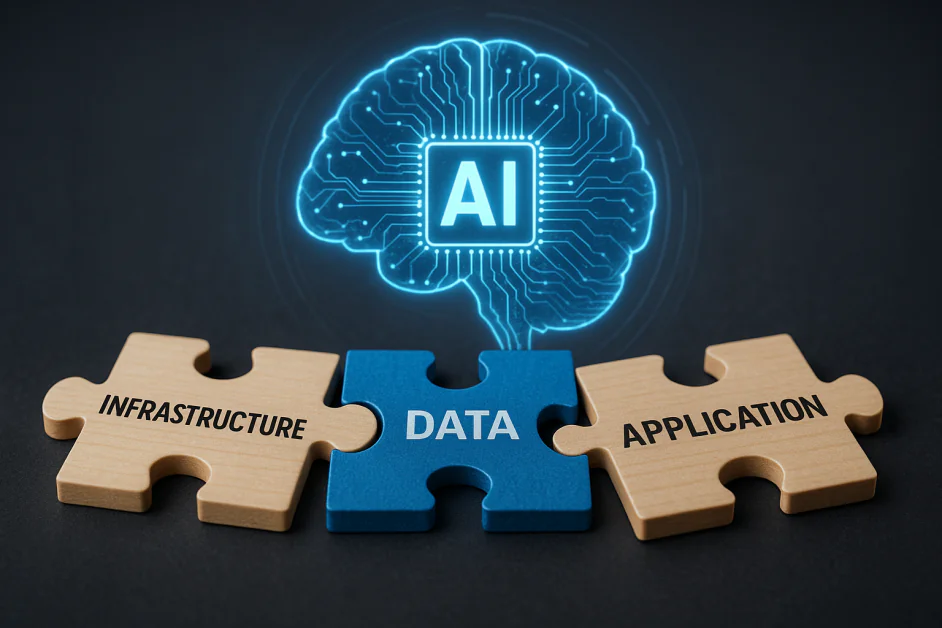Thought Leaders
Successful AI Adoption Requires 3 Components — Most Companies Only Have 2

At this point, AI is no longer new technology. Its proven efficacy in data analysis, pattern recognition, and knowledge synthesis can make teams more efficient. But despite AI’s undeniable value, new research indicates that just 13% of businesses have adopted it in an extensive way. Most businesses are playing it safe, only using AI for the lowest-risk tasks. What’s stopping brands from plunging in and reaping the benefits? The gap between AI aspirations and achievement boils down to a structural shortcoming.
The missing link.
Successful, widespread AI adoption requires three components: infrastructure, application, and data. The infrastructure layer comprises the AI model, whose framework directly shapes usage and potential outputs.
The application layer is where the software solutions live. This is where the bulk of AI’s value gets generated; it’s where users interact (perhaps indirectly) with AI and review its outputs; it’s the nexus of AI-informed decision-making.
In between these layers is the data layer, and it’s this component that most businesses have trouble with – whether they’re aware of it or not. This layer, of course, contains all the data; data that fits into the underlying AI models and guides the applications being built. The quality of the data layer directly informs the output at the application layer. High quality, plentiful data can support robust use cases, while questionable or inadequate data cannot.
Until organizations can build – or partner with businesses that build – all three layers of AI adoption, they won’t derive maximum value.
The implications of imbalance.
AI’s output will always be predicated on the data it’s fed. If an organization wants its AI to be able to predict synthetic molecular structures, they’ll need to feed it a lot of physics data. If a retailer wants to use AI to predict users’ behavior and improve digital experiences, they’ll need to feed it behavioral data.
If businesses (or their partners) can’t adequately support their AI tools with sufficient data, the implications will be far-reaching. First, there’s the AI solution itself. At best, it will be technically operational, albeit not to the degree desired. Outputs may be weak, lackluster, or devoid of insights altogether. Beyond this “best-case” result lies a more probable outcome: AI hallucinations, erroneous outputs, and negative ROI. Not only will the investment have been wasted, but organizations may have to spend more in the name of damage control.
Zooming out from the immediate ramifications, we can see the broader implications of a data-starved AI solution. Generally speaking, businesses adopt AI so they can do more: glean more insights, serve more customers, operate more efficiently. If organizations pour time and resources into an AI tool that falls flat, they’ve effectively stymied their own growth, limiting their ability to adapt with the market and edge out the competition. That puts them at a disadvantage and will leave them scrambling to make up for lost time, resources, and – potentially – customers.
But hope is not lost; there’s plenty organizations can do to position themselves well, correct (or preempt) an AI imbalance, and move forward.
Filling the gap with the right data.
At the risk of oversimplifying, the best thing leaders can do to avoid an AI imbalance is to perform their due diligence before moving forward with any AI-powered solution. Before deploying a new tool, take time to learn about where the data comes from and how it’s generated.
If your solutions provider or lead engineer can’t give you a straight answer about the source, quality, or quantity of the underlying data,that should set off alarm bells. Get a second or third opinion from channel partners and integrators. Crowd-source intel by tapping into user discussion networks like Reddit and Discord; see where other adopters ran into hiccups or roadblocks. Knowing what red flags to look for before making any decisions can help leaders avoid a world of headaches and missed expectations.
Of course, this foresight isn’t always possible and won’t help organizations in the thick of an AI data shortcoming. If scrapping the existing solution isn’t an option, the next best thing is finding a way to inject more data so the tool has more context, patterns, and insights to draw from.
Synthetic data is an option here, but it’s not a cure-all. It can be difficult to pinpoint the precise origin of synthetic data, so it may not always be the best path forward. That said, there’s a time and a place for synthetic data. For instance, it excels at training AI security models, especially in an adversarial manner. As always, conducting upfront research before plunging in headfirst will help leaders make the best decisions for their business.
For industries like retail or quick service restaurants (QSR), human data is preferred. Businesses in these industries are likely using AI to help optimize their customer experience, so their tools should be trained on human behavioral data. For example, if you’re hoping to predict how far users will scroll down on a page, you’d want the AI to base its prediction on actual human behavior under similar conditions.
In some cases, getting an influx of human data isn’t so much about obtaining new data as it is activating existing data. The site and app visitors are already there – it’s just a matter of capturing, structuring, and analyzing their behavioral data so AI tools can use it.
At the end of the day, having insufficient data is better than having bad data; anything organizations can do to scrub their solutions will help drive better outcomes.
Where to begin.
Being short on AI data can pose a sizable challenge for organizations of any size, and it can be daunting to even think about what next steps might be. But even recognizing the issue is an achievement in and of itself. From there, it’s about finding the manageable, incremental steps you can tackle one by one.
AI holds tremendous promise – but only for those willing to invest in each of its key components: infrastructure, application, and data. Without these layers, even the most elegant AI solution will fall flat. The organizations that close the data gap now won’t just avoid falling behind; they’ll be setting the pace.












